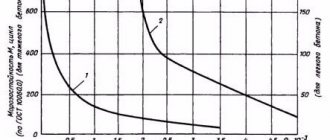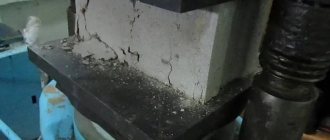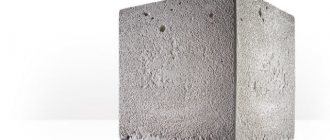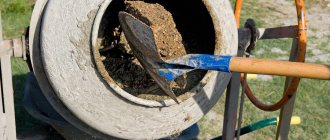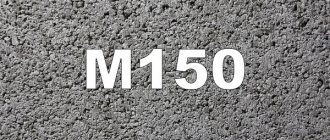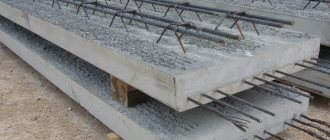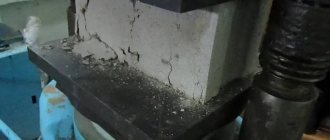When starting construction, it is necessary to study the classification, properties, and labeling of the materials used. It is likely that to perform some work you will not have to overpay money to purchase or prepare high-quality concrete mixtures, but you will be able to use M50 concrete, marked according to the usual classification or B3.5 - according to the international one. This material belongs to the heavy category, but has low strength and is used in the construction of non-critical structures.
What is concrete and its primary indicators
Concrete is a mixture of cement with water, sand and crushed stone. This mixture hardens after installation. In addition to sand, gravel, granite and limestone are used when preparing concrete mixtures.
The primary indicators of concrete - grade and class - are one of the fundamental characteristics when choosing a mortar. The use of different marks varies depending on a range of encrypted values in an alphanumeric format. The finished mixture is usually ordered by brand - the main characteristic is the strength of the future monolith.
1.
In the design documentation, the brand is indicated by the capital letter M and the indicator of the ultimate strength of concrete in kgf/cm2. There are grades of concrete from M50 to M1000, but use is most often limited to M100-M450.
2.
Concrete class, letter B (B 3.5 – B 60). It implies a guaranteed strength value, that is, a load in megapascals that the monolith must withstand in 95% of cases. In operation, the most common classes are B 7.5 – 35.
3.
The indicators of frost resistance, water resistance, mobility, and rigidity are inferior to the above, but are also important in a number of specific cases.
Production technology
Mixing of class B3.5 concrete occurs in strict accordance with the requirements of GOST 7573-2010 (Concrete mixtures. Technical conditions). Production stages:
- preparation of components. At the construction site, dry components are cleaned from impurities and organic substances. Only technical water is used for the solution without any additives;
- dry components are placed in a container, where they are pre-mixed and then liquid is added;
- adding a plasticizer to increase strength and extend service life. Sometimes this stage is skipped if the concrete is laid in a thin layer and will not experience significant loads.
After pouring, class 3.5 concrete is covered with a layer of hot bitumen or compacted. This is done in two ways:
- the roller is being driven;
- the entire surface of the solution is vibrated to expel air bubbles.
This way, even thin concrete will acquire the necessary density and last much longer.
After pouring into the mold, the concrete mixture is left to gain strength. This is best done at a temperature of 15-25 °C. This way the mortar does not lose the necessary moisture, which has a positive effect on its service life. The surface should be regularly inspected for cracks.
Strengthening process
Chemical reactions to bind all components of the mixture begin immediately after mixing begins. The process of gaining strength in the final product occurs in waves, and over time the rate decreases:
- poured concrete gains up to 60% hardness within the first 5 days;
- the concrete mixture hardens by 70% after 10 days from the date of filling the form;
- the finished product hardens completely 28 days after concreting.
To increase the strength indicators, the concrete surface is covered with a film for a month to increase the hydration period. At temperatures exceeding 25 °C, the concrete layer should be watered with water to ensure smooth progress of strength gain.
Concrete class
The strength grade of concrete is directly related to the class of this material. However, the latter is a more accurate and specific meaning. After all, the quality of the finished concrete, in addition to the filler and the brand of cement, can be influenced by many other factors. For example, the type and purity of filler, sealer and binder, as well as pouring methods, hardening conditions, etc.
When determining the class of concrete, its grade, as well as correction factors, are taken into account. It is calculated according to the formula:
B = R*(0.0980655*(1 – 1.64*V)),
where R is the average strength of the material (grade),
V – coefficient of variation.
We found out that there is such a thing as concrete grades. Both their characteristics (the correspondence table will clearly show this) and the scope of use in most cases coincide with the classes. However, the latter indicator is indicated not in kgf/cm², but in pascals. The parameter 0.0980655 in the above formula is precisely the transition coefficient from one unit of measurement to another.
So, a certain brand of concrete usually corresponds to its specific class in terms of strength. However, sometimes the average and actual strength of this material differ quite significantly. In this case, the brand and class may not match. For example, concrete grade M200, due to the not very high quality of the filler or cement, may be designated as B10, not B15. The number in the class of a material shows its ability to withstand certain loads in MPa. Thus, B25 concrete can withstand pressure of 25 MPa without harm.
Price of class B 3.5 concrete mixture
The cost of a material is calculated based on the components included in its composition. The cheapest way is to order B3.5 concrete from the person who produces it. By excluding resellers and intermediaries from the supply chain, you will receive a price that does not contain unnecessary overpayments.
Prices for M50 concrete can be found in the price lists, which are posted in a special section of the RBU website. This information is regularly updated and therefore corresponds to current values. The price includes VAT, but does not include delivery. To calculate the full amount of shipping costs, contact the concrete plant managers in any way convenient for you.
Compliance with brand and class
When carrying out various types of construction work, you often need to know what properties differ between one or another type of mortar. Let's consider what qualities specific brands of concrete have. Both their characteristics (the table presented below will certainly be useful to many builders) and the scope of application, as already mentioned, in most cases correspond to the properties of a certain class.
| Class | Brand | Strength (kgf/cm²) | Application |
| AT 5 | M75 | 65 | As plaster |
| V7.5 | M100 | 98 | Installation of curb stones |
| V12.5 | M150 | 131 | |
| B15 | M200 | 196 | Screeds, tracks |
| B22.5 | M300 | 294 | Foundations |
| B25 | M350 | 327 | Monolithic walls, reinforced concrete products |
| B30 | M400 | 393 | Bridges, bank vaults, airstrips, hydroelectric power plants |
Thus, we have reviewed in general terms what concrete grades are and their characteristics. The table shows that the scope of application of this material depends mainly on its strength. Next, let's take a closer look at how each class is specifically used.
Areas and features of application
Due to its low strength, class B3.5 concrete is used mainly in the preparatory stages of construction:
- pouring the construction site to level the surface before concreting with the main solution;
- concrete pad laid under the base of the road and sidewalks;
- rough filling of floor screeds that will not experience heavy loads;
- pouring pillars and fences.
Class 3.5 concrete, although not highly durable, is still used in some construction work. Contractors are attracted mainly by its low price.
Concrete M100 and M150
The M100 grade material does not have high strength. This brand is usually used for plastering walls and carrying out preparatory work when pouring road surfaces. For the construction of a foundation, M100 is suitable as a footing - a flat platform on which a reinforcement frame is installed.
It is also possible to use concrete of this grade when installing curbstones that are not subject to special loads, pouring low-traffic sidewalk paths, i.e., everything that does not require high strength loads.
Concrete grade M150 has approximately the same strength characteristics as M100. The material is quite durable for the construction of structures that are not subject to high loads, but not reliable enough for pouring “serious” objects.
Where is M50 concrete used?
Due to low technical characteristics, the use of M50 concrete is limited to such areas of construction production where high strength of the material is not needed. It is used:
- to create a preparatory layer for slab, columnar and strip foundations, or devices of the first level of such foundations;
- for the purpose of filling the subfloor;
- curbs, curbs and preparation for them are made from M50 B3.5 concrete;
- when strengthening the soil during the construction of concrete platforms for various purposes;
- when installing a radio-absorbing or radio-isolating barrier.
The main advantages of this product are its low cost and simplicity in the selection of raw materials. These are the main reasons to use it without any restrictions for any preparatory work and construction of temporary buildings.
Frost resistance of concrete
The frost resistance of concrete is indicated by the letter F (25 - 1000), which means the number of freezing and defrosting cycles during which the mixture does not deform. This indicator is extremely important for foundations in very wet soils, bridge structures where there is constant contact with moisture, especially in autumn and spring during periods of temperature changes.
Various manufacturers additionally introduce antifreeze additives into the composition to increase the material’s resistance to temperature changes. Typically, such an additive is a hydrophobic (stressing) cement. Important: abuse of such means will result in a loss of concrete strength. For our climate zone, the use of concrete with frost resistance F 100-200 is suitable.
Properties and characteristics
- Compressive strength – 46 kgf/cm2;
- Frost resistance is quite low - F50 - withstands up to 50 cycles of freezing followed by defrosting without signs of destruction. The mixture is not suitable for use in areas with sudden temperature fluctuations;
- low level of water resistance – W2;
- stiffness coefficient – Zh4;
- density – up to 500 kg/m3.
Advantages
Concrete class B3.5 is purchased by construction organizations and individuals for the following reasons:
- low price per 1 m3;
- availability;
- the ability to lay it in a thin layer and increase the area of the concrete surface.
Flaws
Along with the advantages, there are also some disadvantages of class B3.5 concrete, which builders take into account when purchasing components for the concrete mixture:
- low compressive strength;
- formation of cracks when exposed to low temperatures;
- destruction and shedding of particles under the influence of wind and moisture;
- the low waterproof rating makes it necessary to consider a waterproofing layer to prevent subsidence of the concrete layer.
Waterproof
Water resistance is a characteristic of a concrete mixture based on the bond strength within the material. The importance lies in the fact that water, penetrating into microcracks, destroys it from the inside when it freezes.
Water resistance is indicated by the sign W from 2 to 20 - this is a numerical indicator of resistance to the penetration of moisture into the thickness under pressure. To achieve the required hydraulic resistance characteristics, the same hydrophobic cement or other sealing and hydrophobic additives are used.
It is worth noting that the price will be much higher, but a number of positive qualities will appear:
- the opportunity to save on waterproofing foundations in areas with close groundwater;
- extension of service life due to increased frost resistance, in relation to unprotected structures, such as fences, blind areas, concrete paths.
Technical characteristics of concrete B3.5
The low cement content, as well as the abundance of solid aggregate, explain the low strength of the mortar, which is maintained even with its high rigidity. When purchasing M50 concrete for construction needs, it is worth remembering its basic technical characteristics:
- strength class - B3.5;
- maximum load - 46 kgf/cm²;
- moisture resistance - W2;
- frost resistance - F50;
- mobility - P2-P4;
This solution is not suitable for creating structures that are in constant contact with water. Products created with its help will withstand a relatively small number of thawing and freezing cycles. This means that the concrete mixture is unsuitable for construction in regions with harsh climates. Certain characteristics of the master can be improved by the manufacturer by including plasticizing additives and modifiers in the composition. Therefore, even at the stage of ordering a building mixture, describe its intended purpose so that RBU technologists can select the necessary components and additives.
Proportions of cement, sand and crushed stone to produce concrete of a certain grade
To calculate the ratio of concrete components, the volume of cement is taken as 1 part. The volume of other components is determined according to the information in the table below.
Thus, the proportion per 1 m3 for grade M200 using M400 cement weighing 280 kg, sand 740 kg and crushed stone 1250 kg will take the following form: 1: 2.8: 4.8. A prerequisite for obtaining good cement is a water content of 20% of the total volume (180 l).
Table of proportions for obtaining concrete of a certain grade
| Concrete grade | Cement brand | Ratio of parts by weight, kg | Volume ratio, l | ||||
| Cement | Sand | Crushed stone | Cement | Sand | Crushed stone | ||
| M200 | M 400 | 1 | 2,8 | 4,8 | 10 | 25 | 42 |
| M 500 | 1 | 3,5 | 5,6 | 10 | 32 | 49 | |
| M300 | M 400 | 1 | 1,9 | 3,7 | 10 | 17 | 32 |
| M 500 | 1 | 2,4 | 4,3 | 10 | 22 | 37 | |
| M400 | M 400 | 1 | 1,2 | 2,7 | 10 | 11 | 24 |
| M 500 | 1 | 1,6 | 3,2 | 10 | 14 | 28 | |
| M500 | M 400 | 1 | 1,1 | 2,5 | 10 | 10 | 22 |
| M 500 | 1 | 1,4 | 2,9 | 10 | 12 | 25 | |
Where is it used?
Concrete class B35 grade M450 is used in the construction of facilities:
- bridges, overpasses, platforms;
- hydraulic structures - dams, dams, reservoirs, wells, reservoirs, water parks;
- foundations for multi-storey and industrial buildings;
- load-bearing columns, beams, crossbars;
- tunnels, bunkers, communication routes;
- metro stations;
- airfield runway coatings;
- floors of warehouses and factory workshops;
- nuclear power plants;
- military structures, protective shelters.
Due to its resistance to dynamic loads, class B35 concrete has found application in the construction of highways and the construction of objects in seismically hazardous areas.
To protect against radiation, structures are reinforced with metal mesh, fiber or shavings. This further increases the density of the material and creates an impenetrable barrier to radiation.
Ready-mixed concrete grade M450 is not used in private construction, where the loads are relatively small. The use of excessively strong material is not economically justified. Its cost is high, and creating an excessive safety margin in lightly loaded structures is impractical.
Main characteristics
According to the classification, B35 concrete is classified as structural and is used for critical elements. The technical parameters of the material must be examined in the laboratory. Compliance of the characteristics with the standard is checked in accordance with GOST 10180-2012 and 7474-2010.
The concrete mixture is tested in production for the following qualities:
- Mobility - the workability of the solution depends on it. For B35, the normalized figure is 10-25 cm of cone draft, which corresponds to grades P3-P5.
- Hardness is the vibration time for the moment of filling a special form. For concrete class B35, the characteristic is 21-40 s, marked as Zh3-Zh4.
After 28 days, the samples are subjected to a series of tests, during which the following is determined:
- density - depending on the characteristics of the filler, it ranges from 2500-3000 kg/m³;
- strength - for grade M450 no less than 458 kg/cm²;
- frost resistance - determined by design requirements, regulated by the use of additives, usually not lower than F300;
- water resistance - W8-12, for underground and hydraulic structures W14.
For structures subject to abrasion, the abrasion grade is determined once every six months. Concrete B35 must correspond to G1, G2.
Additives of plasticizers change the properties of concrete - they increase density, water resistance, frost resistance, improve workability, and extend the life of the solution.



